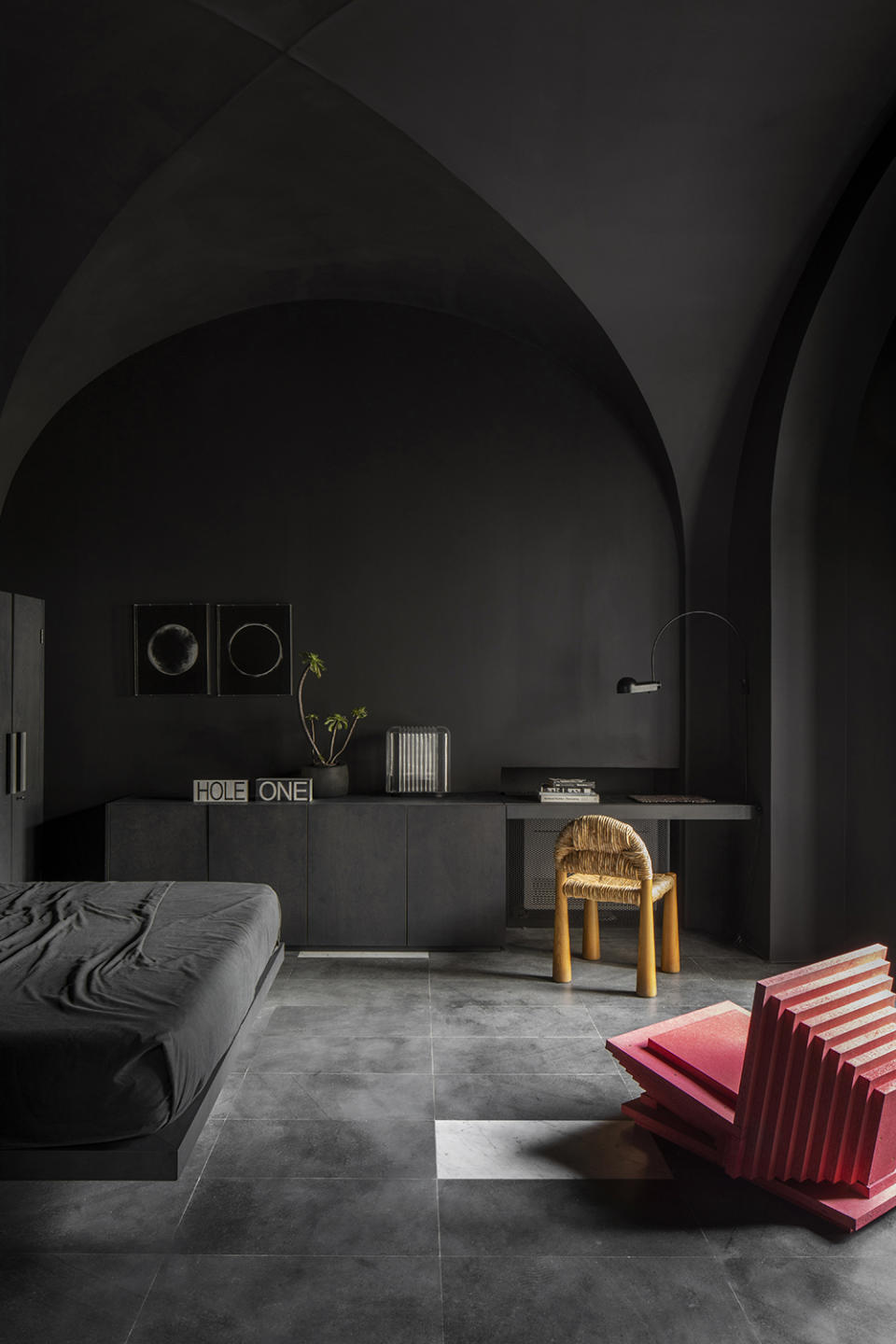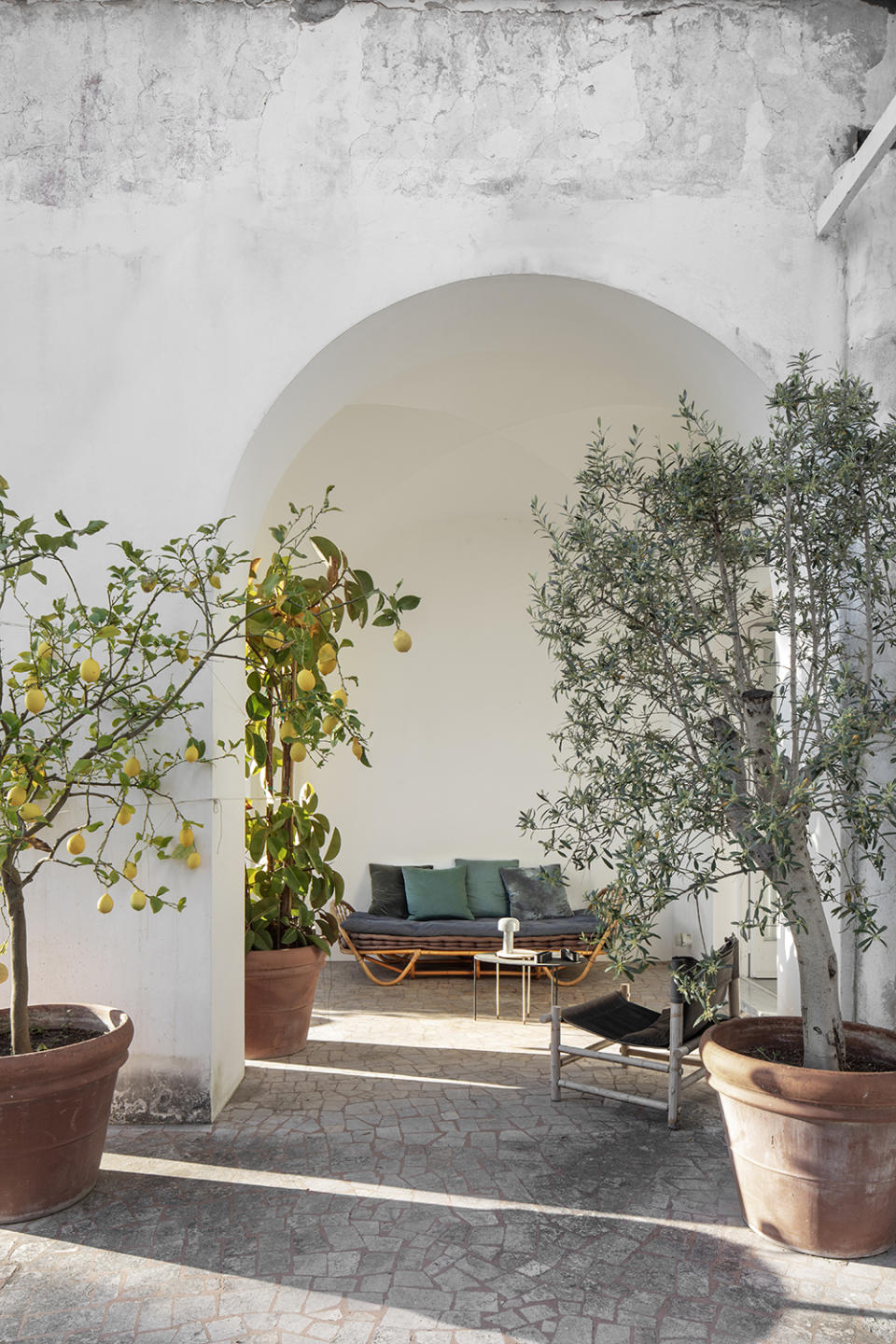Inside the Moody Capri Villa Where the CEO of Valextra Goes to Recharge

Capri has long been a byword for Mediterranean chic, its status as a see-and-be-seen party resort established in the first century B.C.E. by the island’s original celebrity second-home owner, Caesar Augustus. His successor, Tiberius, liked it so much he moved in full-time. After lying fallow for over a millennium following the fall of Rome, Capri was reborn as a destination for bohemian expats in the 19th century and as a playground for La Dolce Vita–era starlets in the 1950s and ’60s. Its glamorous reputation still draws the glitterati. Yet those who leave the boutiques and pastel-hued pizzerias behind and follow the mountain trails to the island’s south side will discover a more private enclave. Here, a Parisian émigré and his family have created a starkly contemporary home that is, in the words of its architect, “the antithesis of the popular image of Capri.”
This antithetical dwelling sits at the top of a steep footpath cut into the side of Monte Tuoro, on Capri’s southeast corner. The large 1930s villa overlooking the Tyrrhenian Sea was split into six apartments after World War II, and the first floor has been transformed by Luciano Giorgi, a Milanese architect, into an austere space that rejects the traditional ornamentation of southern Italian design, a style typified, he says, by the exuberance of colored majolica pottery. Instead it pays homage to the island’s Villa San Michele, built around the turn of the 20th century in elegantly stark black and white. Giorgi redefined his clients’ 1,600-square-foot three-bedroom residence in white Carrara marble and the black lava stone common to southwest Italy, home to three still-smoldering volcanoes.
More from Robb Report
This Modern Home in India Was Designed With Ancient Traditions in Mind
How a Young French Designer Makes Tables That Look Like He Captured the Ocean
These contrasts between light and dark, seclusion and revelry, appeal to the apartment’s owner, Xavier Rougeaux, CEO of Valextra, the Italian luxury leather-goods brand. “If you’re looking for a place where you can rest, relax, enjoy beautiful views, but at the same time want to party and be near glamorous places and people, you’ve got both,” he says.

A Parisian based in Milan, Rougeaux, 51, travels to Capri frequently with his husband, Eric Bales, and their 2-year-old son. The couple bought the apartment in 2016 just as Rougeaux was about to start a new job at Loro Piana; he commissioned Giorgi, with whom he had worked professionally, to modernize the flat while preserving its integrity. A move to London in 2018 to become CEO of Smythson meant Rougeaux had to sign off on the finishing touches from a distance, but since returning to Milan for Valextra in 2021, he and his family have made Capri their true getaway.
Rougeaux and Bales let Giorgi take the lead. “We were willing to give him freedom of expression because I have a lot of respect for creative minds,” says Rougeaux, “and I feel that if you constrain them too much, then you get something that’s an in-between.”
Giorgi’s aim was to show “a different image of Capri,” restoring the structure to its previous simplicity—before the advent of mass air travel put the island within easy reach of summer tourists. Out went the colored ceramic floor tiles, but the original high, arched doorways stayed. “Luciano’s idea was to start with classical white marble,” says Rougeaux. “Step-by-step it is contaminated by black lava stone until [the design culminates] in the main bedroom and bathroom, which are completely black.” According to Rougeaux, Giorgi decided “to go really the whole way—the furniture, the paintings, and the decoration are all in black, so that it becomes quite unique as an atmosphere.”
For Rougeaux, this enveloping darkness creates “a sense of serenity.” On the lush island, he says, “colors are everywhere. So it’s almost as if the interior is cleansing.” Capri’s intense sunlight “kind of squeezes and flattens everything, you know—it almost wipes out the sense of color.”

Giorgio decided to contain the light by sculpting it, utilizing shadows both real and artificial, or trample l’oeil, to create a pattern of chiaroscuro. For example, the kitchen, living, and dining, areas are all combines into one room but separated by chromatic effects: The white living spaces gives way to a dark-hued dining table, which in turn leads to a kitchen painted “completely black, visually absorbed by pitch tones,” Giorgi explains. The result is that the kitchen “almost disappears,” according to Rougeaux, leaving the focus on the living and dining areas.
Giorgi’s most overtly playful conceit is a shadow arch seemingly projected onto the wall by the table, an allusion to the white arches found in the vaulted ceiling. Created by a strip of black lava stone that runs along the floor under the table and up the wall, it adds a hall-of-mirrors reflection, which Giorgi describes as “an echo, a shadow of tradition.”

The apartment’s multiple (real) white arches produce an almost monastic atmosphere in photographs, but the inspiration was less ecclesiastical than elemental. “It’s more this notion of simplicity and minimalism,” says Rougeaux. “When you look at the bench or the table, it’s a big, square, flat tray on two logs.” The aim is to condense everything down to its pure essence, albeit with sophisticated touches, such as a thin bronze line cutting through the table and benches.
Life with a toddler tends to defeat even the most committed minimalist. “You can imagine that with a 2-year-old son, it’s not as pristine when we are living there as it looks in the picture,” says Rougeaux.
Many of the furnishings are of Giorgi’s own design, including the kitchen cabinets in black-stained oak, all the bedroom fittings, the bathroom mirrors and washbasins, and an ingenious alcove. Concealed behind three brass sliding doors, it serves as a tiny bedroom, with a floor divided into sections that easily lift to reveal hidden storage space. Other items provide a tactile counterpoint to the severely smooth interiors, including a pale-blue sofa upholstered in Loro Piana velvet and cashmere and a fluffy black-sheepskin chair on wheels by Cini Boeri for Arflex, which Rougeaux says is a hit with his son.
The enveloping darkness creates a “sense of serenity.” On the lush island, “colors are everywhere. So it’s almost as if the interior is cleansing.”

Both client and architect agree that the renovation itself was straightforward, if unhurried. Rougeaux notes that any outsider undertaking building work must learn to respect the local approach to time. He says he found it helpful to focus on “the beauty of wishing.”
A ban on cars in the Monte Tuoro section of Capri also lent a certain piquancy to the refurbishment, as all the construction materials had to be brought in on foot or by electric golf cart. The steep gradient of the path to the house makes you feel you “deserve the place, somehow,” says Rougeaux.
The villa’s juxtapositions extend beyond its cool, bichrome interior to the vibrant, semi-wild exterior, where a series of terraces are swathed in abundant native foliage, pierced by the distant brightness of the sea. “That contrast between the deep green and the deep blue of the sea and the sunshine is very beautiful,” says Rougeaux. “We wanted to keep that sense of harmony.”
The couple regularly entertain friends outside. “It’s very bucolic,” says Rougeaux. “You do a nice pasta with friends, and you’re looking at the sunset and just enjoying the moment.”
For Giorgi, the pleasure of the project lies in its Edenic innocence. “Xavier and I had the opportunity to create something that can only be in this particular place, by the sea, hidden in the pine forest,” he says. “Now the island is invaded by tourists, but I think that our goal has been achieved, bringing us back to a very ancient time, when few people were here, absorbed in the quietness.”
Best of Robb Report
Sign up for Robb Report's Newsletter. For the latest news, follow us on Facebook, Twitter, and Instagram.


